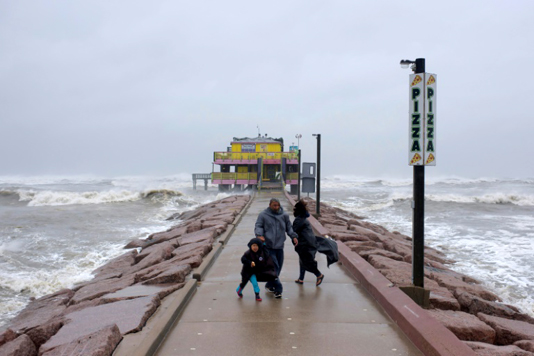LAKE CHARLES, United States, Oct 10, 2020 (BSS/AFP) – Hurricane Delta made
landfall on the Louisiana coast Friday evening, packing ferocious winds and a
“life-threatening” storm surge — and driving out residents still rebuilding
from a devastating storm less than two months ago.
Delta became the 10th named storm of the year to make US landfall, a
record, meteorologists said.
It roared ashore near Creole, Louisiana as a Category 2 storm on a scale
of five, with winds of 100 miles per hour (155 kilometers per hour), the
National Hurricane Center said.
“Damaging winds and a life-threatening storm surge continue over portions
of southern Louisiana,” the Miami-based center said, adding that one
monitoring site was reporting a storm surge of eight feet (2.4 meters) above
ground.
The storm — which the NHC said quickly weakened to a Category 1 as it
moved inland — caused widespread power outages in the state.
In Lake Charles, a city in southwest Louisiana that was hit hard by
Hurricane Laura on August 20, the streets were deserted Friday as a steady
rain fell ahead of Delta’s arrival.
The city is still in disarray from the more powerful Laura, which was a
Category 4 and ripped roofs off houses and uprooted trees. Streets are still
littered with debris.
“I don’t even know if we’ll have a house when we come back,” said resident
Kimberly Hester.
“I just pray to God every night we can at least have a house to come home
to.”
Arthur Durham, 56, was finishing covering windows at his home with plywood
as protection against flying debris.
“I stayed for the last one. I’m pretty well prepared. I have a generator
back-up, tools, equipment… I’m pretty self-sufficient,” he told AFP,
adding: “I’m used to this.”
– Battered US Gulf –
Earlier, Louisiana Governor John Bel Edwards announced that 2,400 National
Guard personnel had been mobilized to aid locals.
Hurricane Delta will hit “in the area of our state that is least prepared
to take it,” he said late Thursday.
In Lake Charles, Shannon Fuselier drilled plywood over the windows of a
friend’s home. Many neighborhood houses are covered with tarps from previous
hurricane damage, and the home Fuselier was working on had already suffered
roof damage from a fallen tree and smashed windows during Laura.
“The branches and leaves don’t do that much damage,” said Fuselier, 56.
“It’s pieces of metal, steel, frames of other people’s windows, signs from
people’s stores, nails.”
Fuselier said she was staying because she didn’t think the storm was
strong enough for her to flee.
Edwards has already warned that Delta could sweep up old debris and hurl
it like missiles.
Traffic was jammed Thursday as people left Lake Charles.
Terry Lebine evacuated to the town of Alexandria, some 100 miles (150
kilometers) to the north, during the previous hurricane, and was ready to
head out again.
“It’s exhausting,” she told AFP. “I’ve got my mother, she’s 81 years old
and not in the best of health. Right after we went back home after Laura, we
have to leave again for Delta. We were home a good two to three weeks.”
The storm toppled trees and tore down power lines in Mexico’s Yucatan
Peninsula Wednesday as it swept over the western Gulf of Mexico. But the
region escaped major destruction and no deaths were reported.
Delta is the 26th named storm of an unusually active Atlantic hurricane
season.
In September, meteorologists were forced to break out the Greek alphabet
to name Atlantic storms for only the second time ever, after the 2020
hurricane season blew through their usual list, ending on Tropical Storm
Wilfred.
As the ocean surface warms due to climate change, hurricanes become more
powerful. Scientists say there will likely be an increase in powerful
Category 4 and 5 storms.



